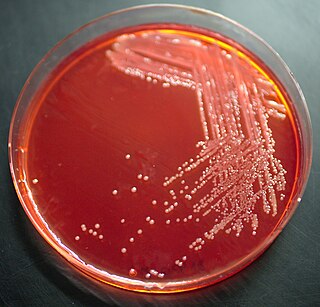
The brown rat, also known as the common rat, street rat, sewer rat, wharf rat, Hanover rat, Norway rat, Norwegian rat and Parisian rat, is a widespread species of common rat. One of the largest muroids, it is a brown or grey rodent with a head and body length of up to 28 cm (11 in) long, and a tail slightly shorter than that. It weighs between 140 and 500 g. Thought to have originated in northern China and neighbouring areas, this rodent has now spread to all continents except Antarctica, and is the dominant rat in Europe and much of North America. With rare exceptions, the brown rat lives wherever humans live, particularly in urban areas.

Bartonella is a genus of Gram-negative bacteria. It is the only genus in the family Bartonellaceae. Facultative intracellular parasites, Bartonella species can infect healthy people, but are considered especially important as opportunistic pathogens. Bartonella species are transmitted by vectors such as ticks, fleas, sand flies, and mosquitoes. At least eight Bartonella species or subspecies are known to infect humans.

Rattus Norvegicus is the debut studio album by the Stranglers, released on 15 April 1977.
Bartonella talpae, formerly belonging to the Grahamella genus, is a bacterium. As with other Bartonella species, it can cause disease in animals.
Bartonella peromysci, formerly belonging to the Grahamella genus, is a bacterium. As with other Bartonella species, it can cause disease in animals.
Bartonella grahamii is a bacterium. As with other Bartonella species, it can cause disease in animals.
Bartonella taylorii is a bacterium. As with other Bartonella species, it can cause disease in animals.
Bartonella doshiae is a bacterium. As with other Bartonella species, it can cause disease in animals.
Bartonella koehlerae is a bacterium first isolated from cats. Its genome consists of 1.7-1.8 Mb.
Bartonella capreoli is a pathogenic bacteria first isolated from European ruminants. It is small, fastidious, aerobic, oxidase-negative, gram-negative and rod-shaped. Its type strain is IBS 193T.
Pneumocystis wakefieldiae is a parasitic fungus isolated from rats.
Bartonella callosciuri is a bacterium from the genus Bartonella.
Bartonella chomelii is a Gram-negative, oxidase- and catalase-negative bacteria from the genus Bartonella with a unipolar flagellum which was isolated from a domestic cattle. Bartonella chomelii is named after Bruno B. Chomel.
Bartonella coopersplainsensis is a Gram-negative, non-motile bacteria from the genus Bartonella which was isolated from the blood of a wild rat.
Bartonella queenslandensis is a Gram-negative bacteria from the genus Bartonella which was isolated from the blood of rats from the genus of Melomys in Queensland in Australia.
Bartonella rattaustraliani is a bacterium from the genus Bartonella which was isolated from the blood of rats from the genus of Melomys.
Bartonella rattimassiliensis is a bacterium from the genus Bartonella which was isolated from the rat Rattus norvegicus.
Bartonella silvatica is an oxidase- and catalase-negative bacterium from the genus Bartonella isolated from the blood of the large Japanese field mouse Apodemus speciosus.

Yersinia hibernica is a species of Yersinia that was originally isolated in a pig-production environment. The type strain is CFS1934. This species has previously been misidentified as Yersinia enterocolitica and Yersinia kristensenii but it may be distinguished biochemically by lack of sucrose utilization. In addition to pig related environments, Y. hibernica has also been isolated from the feces of Rattus norvegicus and Hydrochoerus hydrochaeris.
Bartonella gabonensis is a bacterium from the genus Bartonella which has been isolated from the mouse Lophuromys sp. which was living in Franceville.



